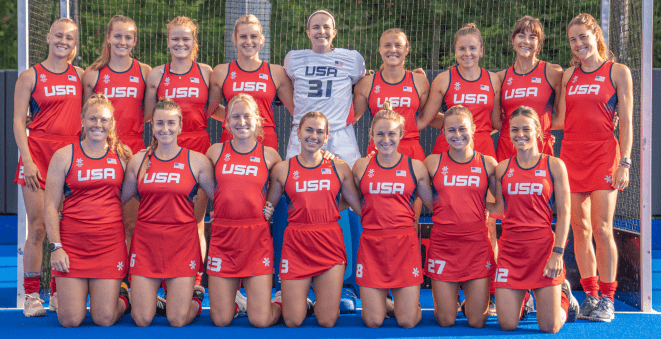Beth Rudge could hardly see herself as an ambitious runner at one point in her life.
The 41-year-old encountered self-doubts during her college years, when she wasn’t breaking any personal records.
“The one cross country season I did at York (College), it was terrible,” Beth said. “It was horrible. It was totally mental. I couldn’t understand why I was running minutes slower than in high school. It was a mental block. I didn’t run again until my senior year. I ran track and field, and suddenly, I was a runner again.”
That was the beginning of Beth’s personal growth on how to stop overthinking.
A husband, three children, and two decades later, she picked running back up and added two more events. A close friend, Stephanie Ernst, introduced her to triathlons, which reignited Beth’s inner athlete.
With dedication, discipline, and grueling workouts, the Boiling Springs resident competed in the 2022 World Triathlon Championship final, finishing 8th in her age group, in Abu Dhabi, United Arab Emirates last November.
“I’m in the best shape of my life,” she said. “It’s crazy. I wish I could have done this when I had my 18, 20-year-old body. I don’t think that mental focus and competence was there for me at that time.”
Wanting to improve her health and fitness in her mid-30s, she set off to reconnect with her hobby. Running began to become the norm again after birthing her third son, but she then, unfortunately, injured her knee. Biking was an alternative.

“(My friend) taught me how to ride a road bike,” Beth said. “So, I started to road bike in 2017 and she was getting into triathlons. In 2018, she convinced me to try one triathlon. And, I said, ‘I will try one,’ just to get you off my back. And, so I did one. It was terrible. It was in Mt. Gretna (Got the Nerve Triathlon). It was cold. I was frozen. I was like, alright, I can’t judge it on that. That was horrible. I’ll do one more. Who says that? So, the next one, I had a good experience. I felt that competitive drive going again. So, I just kept going from there.”
As Beth increased her workouts, her knee became stronger. And, her attitude toward triathlon workouts changed.
“2018 was my first year of just trying them and training for that,” Beth said. “I guess, the biking and training is what got me back into running again. So, that was neat going from not being able to run much to now being able to run unlimited. That cross training really makes a huge difference.”
For two years, she competed in various triathlons, which is when she started to place at events. She finished in the middle of the pack at a huge event just before COVID-19 pandemic mitigation efforts were implemented. During the height of the pandemic, races dried up. But, she continued to train for the fun of it.
“It was so much fun,” she said. “That kind of fueled the fire even more. The year after, when races started reopening, I went back to nationals with the goal of probably just being top 30 for my age group.”
She did better than that. She placed 20th and qualified for the 2022 World Triathlon Championship final in the Middle East.
“It was exciting because I didn’t know I qualified for world’s that year,” Beth said. “There were carry-over qualifications because of delays from COVID. I didn’t think I had a chance, but then in April 2022, I got an email. Many people decided to not use their carry-over qualification to go. It was a weird way to qualify, but still a very exciting email to get.”
Her 2022 race plans were immediately adjusted, she said.
“I wasn’t quite expecting to do that. So, it made for the longest race season I’ve ever done. I don’t normally do a triathlon in November. That was the best season. I’ve only gotten better and more excited about them each year. I did three races over the summer leading up to nationals again in August. And, I finished 12th in nationals.”
Overcoming swimming jitters
“Swimming is my biggest weakness,” Beth said. “Running is my base and that’s what I can do. I never swam in high school or college. I know how to swim. It’s my weakness and my struggle, but it’s also my most improved, too. I would say, it’s pretty fun to look back to see how much I’ve learned.”
Her mantra was “don’t panic, don’t stop,” in her earlier races to help her try to get over her fears. She began to dig into open water trainings, even learning from a woman who swam the English Channel, to nail that part of the race down, she said.
“Now, I’m starting to race,” Beth said. “It used to be swim to survive and then you get out and then you start racing. But, now I’ve crossed over. That was my best swim. I cut my time there by minutes. It was fantastic.”

Her first Olympic length triathlon swim took 35 minutes. Her time in November was 27 minutes.
Training for an open water swim was tough. There wasn’t anywhere to go that was comparable to what was expected of her in Abu Dhabi. She normally trained at Laurel Lake in Cumberland County, Pennsylvania, which wasn’t nearly as warm as the water in the eastern hemisphere.
“I was thinking, I haven’t swam in open water for three months, haven’t biked outside for three weeks,” she recalled thinking. “I did all my training indoors. It was an interesting transition to go over there; 30 some-degrees to 90 degrees. Got practice swims out there to feel that water. It was warm water.”
Warm water raises your body temperature faster, she said.
“That feels like bath water,” Beth said. “Usually, our water around here is cooler. I race in a wet suit that gives you buoyancy. I had to race without the wet suit; different dynamic and there were some jellyfish, too.”
Beth said she hesitated at the starting line.
“I tend to wait just a few seconds,” she said. “I’ll not immediately jump at the gun. Just wait a couple seconds to let those fast girls go. It’s not good to have people swimming on top of you. You can draft in the water. I’ll try to slip in behind somebody. You have to hope it’s the right person to draft to get some speed and energy. It saves time getting behind the right person.”
Biking and running training
Transitioning to bike and then run is obviously very odd, Beth said.
“It’s that feeling of being in slow motion, get your legs going again, and lungs switched over,” she said. “That’s a mental switch. Ok, start moving. You can do this. You’re not in slow mo. You get to the transition area and there isn’t really any changing at worlds. I ran to the bike transition, threw my helmet on, threw my bike shoes on, and I’m off in my tri suit.”
Beth improved her speed on her road bike from a 17 mph to a 23-mph pace. Her initial running pace was about 8.5 minute mile, which dropped to 7 minutes at world’s, she said.
The progression involved a hard train for 16 weeks, and then a rest from August into September. She kicked back up with an 8-week training program leading up to world’s.

“It was the most difficult training I’ve done,” she said. “Normally, in the fall, I relax and have fun, go for fun bike rides, and run with friends. I’m losing daylight and I’m losing warmth and I’m trying to train for a totally different climate. So, I did the first month, fairly normal outside. For the month leading up, I did have to heat train in the mid-80s to mid-90s.”
She trained before and after work indoors because of daylight, she said. Heat training in a sauna ensued.
“I got a portable sauna that we set up in our basement,” she said. “It was for after heavy, harder workouts. I would set up my indoor training on my bike. I had our electric space heater on a tray table blasting in my face. Then I’d go on a 2-to-3-hour bike ride, followed by sitting in the sauna for 20 minutes. You’re not supposed to rehydrate immediately, but slowly rehydrate for the next three to four hours. It felt like torture upon torture. I love being outside versus being indoors. It’s just not as fun and then you have to sit in a hot box afterwards. It was a long training season, felt never-ending.”
Fueling her body for energy
During her bike and run, Beth said she had to figure out when and what fueling was appropriate to help her energy remain steady.
“Fuel and hydrate, which you can’t do when you’re swimming or when you’re running pretty hard,” she said. “I’m drinking and fueling as much as possible, so that it’s not sitting in my stomach for the run. The bike is a magical balance of racing hard but not enough to not have running legs and fueling your body to finish the race.”
On the bike, she said you can’t draft. Passes need to be appropriate to not get disqualified, she said.
“World’s is technical,” she said. “It’s eight turns, many sharp turns, and there was one that was more than a 90-degree angle but wasn’t quite 180. We were looping around the street; it was a lot of traffic. It was a two-loop course. I was a greater technician on this bike than I thought I’d be navigating through a cluster of bikes. There’s a risk on this course.”
Beth came out of the water 17th and then finished 11th in bike.
“That’s characteristic of my races,” she said. “I come out middle-ish with my swim. I used to come out in the back of the pack. I need to make up my time on the bike. I figured out a good balance. I’m still making those good passes and I have a really good solid bike. I’m able to preserve my run. Especially, at world’s in the heat, I’ve been finding that balance. I don’t crash and burn on my run. I finished with one of my most solid runs. You learn that. It takes a few races of messing up.”
She admitted to “messing up” a healthy caloric intake, as well as proper hydration before hitting the main event, too.
“You read about it, and you have to research and learn, but you have to trial and error what’s best for you,” she said. “The first couple of years, I just did not do it very scientifically. Thinking, ok, I’ll try this or that. I wasn’t that serious about it. This year, buckled down a little bit more and reading some coaching articles on how much hydration and sodium per your own body weight and per your length of the race. How many calories you’re going to want to take in and even 5 hours before race, or 3 hours before race starts. Here’s what you should consume. That made a big difference. That was very helpful. I think I would have underestimated everything. That was fun trying to figure some of those things out.”
She’s happy to have discovered what works for her but she said a triathlete is often working on becoming more efficient.
“I qualified for world’s in Spain in September 2023,” she said. “I’d like to give it another go. I think it’ll be very much strategic again.”
A wife, mom of three running in the Middle East
There was 100 percent sunlight during her final leg of the race, she said. She had grabbed calorie gels and one water.
Race volunteers were handing out ice water sponges. Beth said she stuffed them in her suit, placed them on her wrists, and under her arms.
“A couple times there that’s where the mental game comes in; it’s easy to give up,” she said. “And, honestly, I thought of my oldest son. I pictured myself cheering for him at his cross-country races. I was thinking, you’ve got to walk the walk here. That really helped. Gotta show him it can be done.”

The race took her to the “other side of the world and within close proximity of other global conflicts,” she said.
“So, the travel stress was high, in addition to the performance pressure of racing at a world championship event. The final loop of the run was intense. The bright sun was beating down on us with a temperature of close to 95 degrees. The palm trees and blue skies made you feel as if you were running a race in Florida near the beach.”
There was great “comradery and connection,” she said.
“Never an ounce of hate or animosity on that course. I knew the athletic competition would be intense, but the support within the international triathlon community was inspiring.”
The UPMC nurse practitioner said she races and trains for several reason. And, this race was just another reminder as to why it’s important to continue pursuing your passions.
“One, I find exercise absolutely necessary for my mental and physical health. I also use my own experience with exercise and establishing that routine to counsel my patients. A healthy diet and exercise routine is essential for health promotion and risk reduction. No one is going to stick with an exercise routine that they do not enjoy. So first I tell patients to find some kind of activity they enjoy, whether that is walking, biking, going to the gym. Maybe even let a friend talk you into trying something new or be that friend encouraging someone else. The next important aspect is accountability. Make a plan, write it down, and track your progress. Find a friend who will commit with you, so you have each other to push and encourage. Lastly, 5 minutes is better than zero and you need to start somewhere. Don’t let time be an excuse. All of us can find 5 minutes in the day to move our bodies. You can walk inside the house, walk outside, or walk up and down the stairs. Start with easy and feasible and build from there.”
While she was away, her husband Brian, shared how proud he was of his wife on social media. He made sure Boiling Springs knew that a Bubbler Class of 2000 put up times that were within minutes of elite athletes.
Beth finished in the top 16 percent of all females and a top 10 finish at 8th place in her age group, he wrote on a Facebook group.
“I am so proud of Beth and what she has been able to accomplish in just a few short years competing in Triathlon,” he told FAN. “Beth is a fierce competitor. Whether it’s running a National Championship race or a game night with family and friends, Beth sets her mind on winning. She doesn’t really have any other gear. That level of focus and determination is really inspiring to me but also to our kids. Beth just doesn’t have that mindset of skipping the long swim to sleep in or shortening the run because it’s freezing outside. She can set a goal six or eight months into the future, do the work to plan out how to achieve success, and then execute religiously. My favorite moment in her triathlon journey was at the National Championship race this past summer. We made it a family trip and our three boys were there with me. We raced around from one spot to the next to cheer her on. (I think we did almost three miles of our own race), screaming our loudest, and ringing the cowbell.”
Beth finished the 2022 World Triathlon Championship with a time of 2:22.11.




